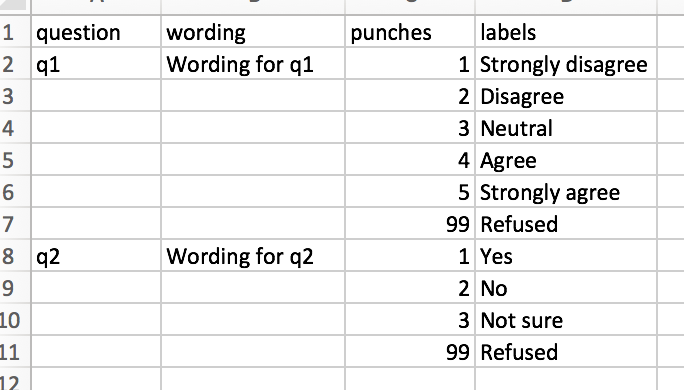Here's something I thought of but there's probably something much more elegant.
# You would import the codebook using read_csv or similar function and not type out
library(tidyverse)
codebook_in <- tibble(question=c("q1", rep(NA_character_, 5), "q2", rep(NA_character_, 3)),
wording=c("Wording for q1", rep(NA_character_, 5), "Wording for q2", rep(NA_character_, 3)),
punches=c(1:5, 99, 1:3, 99),
labels=c("Strongly disagree", "Disagree", "Neutral", "Agree", "Strongly agree", "Refused", "Yes", "No", "Not sure", "Refused"))
codebook_in
#> # A tibble: 10 x 4
#> question wording punches labels
#> <chr> <chr> <dbl> <chr>
#> 1 q1 Wording for q1 1 Strongly disagree
#> 2 <NA> <NA> 2 Disagree
#> 3 <NA> <NA> 3 Neutral
#> 4 <NA> <NA> 4 Agree
#> 5 <NA> <NA> 5 Strongly agree
#> 6 <NA> <NA> 99 Refused
#> 7 q2 Wording for q2 1 Yes
#> 8 <NA> <NA> 2 No
#> 9 <NA> <NA> 3 Not sure
#> 10 <NA> <NA> 99 Refused
codebook <- codebook_in %>%
fill(question, wording)
set.seed(200516)
fakedata <- tibble(q1=sample(c(1:5, 99), 1000, replace=TRUE),
q2=sample(c(1:3, 99), 1000, replace=TRUE))
fakedata
#> # A tibble: 1,000 x 2
#> q1 q2
#> <dbl> <dbl>
#> 1 1 2
#> 2 5 3
#> 3 1 3
#> 4 1 1
#> 5 1 2
#> 6 99 3
#> 7 5 99
#> 8 2 1
#> 9 5 2
#> 10 99 3
#> # … with 990 more rows
newfakedata <- fakedata
for (i in unique(codebook$question)){
codev <- codebook %>% filter(question==i)
newfakedata[, i] <- factor(pull(newfakedata, i), levels=codev$punches, labels=codev$labels)
}
newfakedata
#> # A tibble: 1,000 x 2
#> q1 q2
#> <fct> <fct>
#> 1 Strongly disagree No
#> 2 Strongly agree Not sure
#> 3 Strongly disagree Not sure
#> 4 Strongly disagree Yes
#> 5 Strongly disagree No
#> 6 Refused Not sure
#> 7 Strongly agree Refused
#> 8 Disagree Yes
#> 9 Strongly agree No
#> 10 Refused Not sure
#> # … with 990 more rows
Created on 2020-05-16 by the reprex package (v0.3.0)
